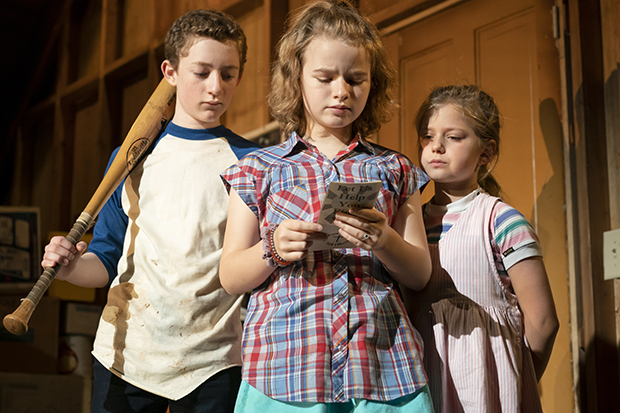Make Believe Reveals the Seriousness Lurking Behind Playtime

(© Joan Marcus)
What would you have done as a child if your mom disappeared one day? It's not just a grim hypothetical question for the four young children of the Conlee family. In Bess Wohl's Make Believe (now at Second Stage Theater), they return home from school to an empty house, which remains free of adults for the next several days. Where did mom go? Will dad ever return from his business trip? How will they feed themselves? Should they keep going to school? Far from the trappings of a delightful Macaulay Culkin comedy, these questions have real repercussions — and the kids work out the answers through make-believe. A testament to the power of pretend, Make Believe grounds itself in uncomfortable realism, resulting in the most thrilling new play of the summer.
The realism starts with the disquieting decision to cast real child actors as the Conlee kids: Addie (an adorable, vulnerable Casey Hilton) tends to her favorite doll in the attic playroom as she waits for her siblings to join her (a preshow sound cue of television noises and a Cabbage Patch doll places us firmly in the 1980s). Her big sister, Kate (a precociously authoritative Maren Heary), is the first to arrive, followed by big brother Chris (Ryan Foust, brilliantly straddling the line between bully and protector). Five-year-old Carl (playful and furtive Harrison Fox) hides out in the plastic cottage, pretending to be a dog. Chris wonders where his usual afternoon snack is, while Kate tries to get some homework done. Hours pass, and then days — but mom doesn't show.

(© Joan Marcus)
The kids kill time by playing house, revealing the fraught domestic situation of the Conlees, in which dad disappears on extended "business trips" and mom cries herself into a stupor. "I know where you go, when you go on your business trips," says Kate-as-mom, clutching a plastic chardonnay glass as she glares at Chris-as-dad. "You're watching television! The boob tube." Fact and fiction, humor and seriousness blend as a clear picture emerges of the circumstances that led up to this moment. Playtime becomes the tool through which the Conlee kids discuss what is happening to them. Answering-machine messages heard through the floor boards (vital sound design by Bray Poor) fill in the gaps. As time passes, Chris (now the man of the house) has to decide whether he will wait for his parents, or take matters into his own hands. When it seems like adults finally do arrive (another hair-raising moment of sound design), the prematurely cynical Kate predicts, "They'll take us, and separate us, and put us in cages."
It would be comforting to dismiss this as childish hyperbole stemming from an overactive imagination. But of course we know that sometimes parents don't come home, and sometimes kids are locked in cages. Wohl violently shatters the myth (if one still exists) that there are rational adults in charge, keeping our kids safe from harm. This isn't something that started in 2016, either: Through these abandoned Gen-Xers, Wohl captivatingly shows how the individual pursuit of happiness, so central to the postwar American narrative, has serious consequences.

(© Joan Marcus)
Wohl allows us to assess those consequences in the long term by flashing forward to the present day, when the Conlees reconvene as adults. Through detailed, resonant performances, adult actors Samantha Mathis, Susannah Flood, Kim Fischer, and Brad Heberlee give us a sense not only of how these kids turned out, but how their individual struggles with happiness and responsibility have impacted that journey.
Michael Greif's finely tuned direction connects each adult to a corresponding kid. The acting does that too: I'm not much of a fan of child actors, but I have to admit that these kids are giving some of the best performances of the year. It makes sense when one considers how so many adult actors spend their careers trying to recapture the kind of uninhibited, honest performances kids give when they're playing make believe.

(© Joan Marcus)
Greif and scenic designer David Zinn have crafted a fully realized play world in which their performances thrive. Stuffed with old furniture and aging toys, the Conlees' attic is a place of lost treasure and hidden secrets. Lighting designer Ben Stanton shows us the passage of time through the natural light beaming through the filthy skylights in the sloped ceiling. Costume designer Emilio Sosa outfits the kids in recognizable period duds: OshKosh B'gosh for the young ones, and aspirational tween clothing for the older siblings. Even if you aren't a child of the '80s, Make Believe will feel uncannily familiar.
That's because only the most repressed adults will be unable to recall a time when make believe was serious business, when the amateur playacting we did in our childhood basements and backyards was a cipher for engaging with our very real dreams and anxieties. Those of us who enjoy the theater still do that. And anyone who loves the theater will recognize the value in Make Believe.










